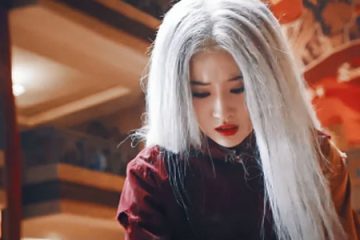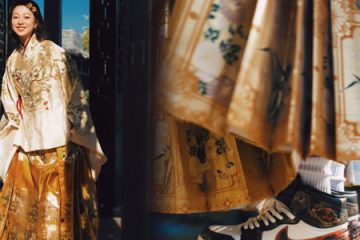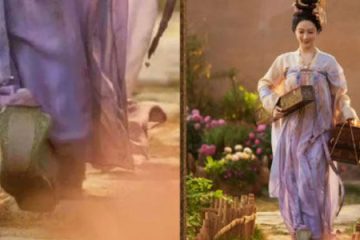Can You Freely Wear White Hanfu in China?

White wedding dresses are undeniably beautiful—that’s just a fact. But have you ever heard about some of the cultural taboos surrounding the color white in Chinese tradition? 🤔
In the eyes of some Chinese people, wearing an all-white Hanfu might look like you’re dressed for a funeral.
Ⅰ. Ancient “White” Isn’t the Same as Modern White
We’ve actually discussed this topic before on the blog: wearing white Hanfu isn’t inherently taboo in Chinese culture. In fact, white was traditionally one of the Five Elemental Colors (五色) and was often associated with elegance and dignity in ancient China.
That said, it’s worth clarifying that what ancient Chinese referred to as “white” wasn’t the same bright, pure white we think of today. Because of the limited fabric bleaching techniques available at the time, the “white” people saw in historical garments was usually more of an off-white—slightly grayish or ivory-toned.
Take a look at the historical white color palette below—you’ll notice it actually resembles soft pastel shades. These tones are easy on the eyes and have a calm, harmonious aesthetic. So, when you see white Hanfu inspired by traditional styles, remember: it’s more about grace and subtle beauty than anything funereal.

Of course, you can also take a look at the Gold Scale set on our website. While it’s described as a white outfit, it’s important to note that it features different shades of white to create contrast and depth.

Ⅱ. Mourning Clothes Weren’t Pure White Either
Interestingly, even traditional mourning garments weren’t necessarily pure white. Funeral attire in ancient China was typically made from hemp fabric, and the phrase “披麻戴孝 (wearing mourning and sackcloth)” directly refers to this practice.
But if you’ve ever seen raw hemp, you’ll know that its natural color leans more toward beige or light khaki, not true white. In this context, “white” likely referred to natural, undyed materials—the most unadorned and humble of colors. During a funeral, this symbolism was intentional: stripping away external finery to show respect for the deceased, symbolizing a return to simplicity and origin. There was no cultural expectation to wear white in the modern, bright-white sense.

Ⅲ. Can White Be Worn in Daily Life?
Absolutely. In fact, white was part of daily fashion in ancient China. For example, in many Ming Dynasty novels, the term “白绫袄 (white silk jacket)” appears quite often. These were especially popular during festivals like the Lantern Festival, when wealthy women would wear them to attend evening banquets and lantern displays.
Here, “white” referred to the color, “ling” (绫) to a type of fine silk fabric, and “ao” (袄) to a lined outer garment worn over the skirt—practical for keeping warm in winter.↓

We’ve talked about the Lantern Festival before—watching lantern displays is one of the most important traditions of the day. It’s a grand event, much like how fireworks are portrayed in Japanese anime during summer festivals, with boys and girls dressed up to celebrate the occasion.
Ⅳ. The Meaning of Color in Chinese Culture
So why do some Chinese people associate wearing all white with mourning? The answer lies in the deep-rooted cultural meanings behind colors in China—particularly white and red, which represent two emotional and symbolic extremes.
🔴 Red
Everyone knows that red is a favorite color in Chinese culture. It symbolizes happiness, celebration, passion, prosperity, and good fortune. From weddings and Lunar New Year to red envelopes and couplets on doors, red is everywhere during joyful occasions.
⚪ White
In contrast, white carries a very different set of meanings. Traditionally, it is associated with death, mourning, stillness, and emptiness. It is often seen as inauspicious. During funerals, people wear white mourning clothes, and items like white paper money and white funeral banners are common. As a result, wearing all white to celebratory events is considered inappropriate—a sign of disrespect toward the occasion.
This long-standing cultural contrast explains why some still view all-white outfits—especially traditional ones like Hanfu—as resembling mourning attire.
Ⅴ. So why wear white?
It all comes down to the sheer brilliance and complexity of the lantern displays. With countless lanterns lighting up the sky in every shape and color, wearing any strong color might easily clash or get lost in the spectacle. But white—white is timeless. It complements all colors and never feels out of place. Under the moonlight, it even reflects a silvery glow, adding a quiet romanticism to the evening stroll.
In classic Ming Dynasty color pairings, white was often matched with blue. The white silk jacket and blue satin skirt combo became a go-to look for many fashionable women of the time. So while wearing all white might seem bold today, back then, it wasn’t unusual at all.

What’s more, in ancient China, scholars and officials often wore plain white as a symbol of their integrity and refined character. As noted in Guanzi: Young Officers: “During the season of harmony, the ruler wears white.” For them, white was not just a color—it was a statement of purity, humility, and virtue.
Summary
So rather than focusing on whether someone should wear white, perhaps it’s more meaningful to think about how to wear it appropriately based on the time, place, and occasion.
you can wear white Hanfu in China. Just like with any cultural garment, awareness and intention go a long way. White Hanfu can be breathtaking, poetic, and elegant — but understanding the cultural nuances behind it will help you wear it with confidence and grace.




0 Comments